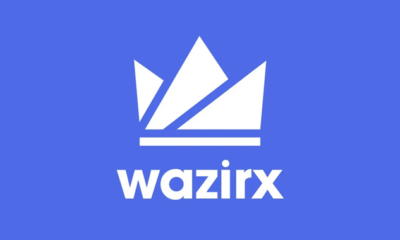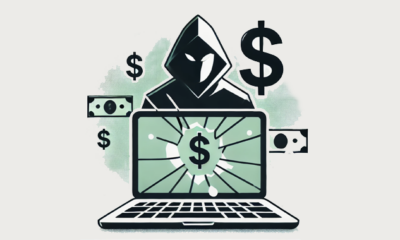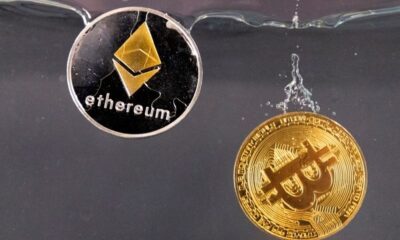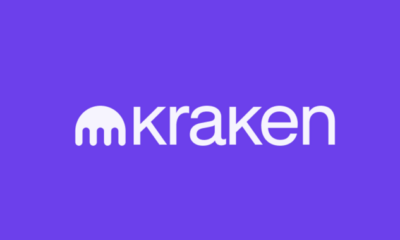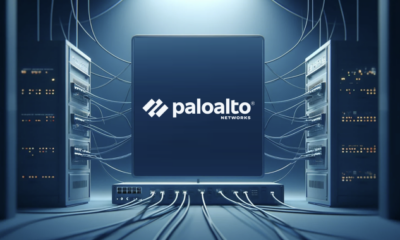Blockchain
How to Use Python to Build Secure Blockchain Applications
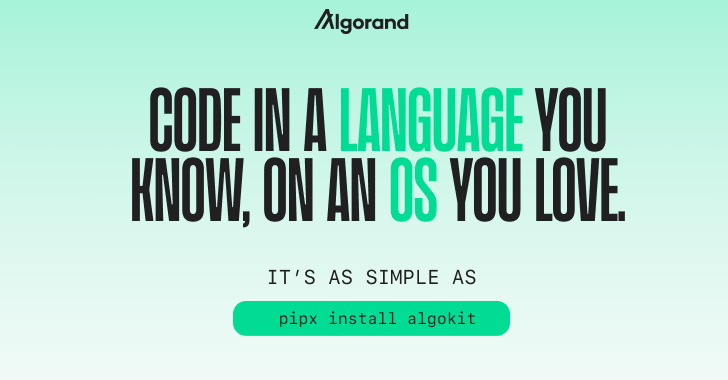
Did you know that you can now build blockchain applications, also known as decentralized applications (or “dApps” for short) in native Python? Blockchain development has traditionally required learning specialized languages, creating a barrier for many developers… until now. AlgoKitan all-in-one development toolkit for Algorand, allows developers to build blockchain applications in pure Python.
This article will walk you through the benefits of building blockchain applications, why Python is the ideal choice for dApp development, how to set up your own blockchain development environment, and how to get started building secure blockchain applications in native Python.
Why build blockchain applications?
Blockchain application development goes far beyond creating a decentralized database and peer-to-peer transactions. Unlock a new level of trust, security and efficiency for various applications.
Ensure tamper-proof records: Blockchain creates an immutable and transparent ledger, ensuring data security and eliminating the risk of manipulation.
Automate complex chords: Smart contracts and atomic swaps eliminate the need for third-party verification, simplifying transactions and reducing costs.
Revolutionize asset ownership: Digitalization enables fractional ownership and secure trading of real-world assets.
Build innovative solutions: Python development skills can be used to create breakthrough applications in artificial intelligence, identity management, and secure IoT data exchange.
Why use Python to build blockchain applications?
Readability and maintainability: Python’s smooth syntax and robust tools make it easy to write, understand, and modify code, especially when working on complex and powerful blockchain projects.
Integration with other technologies: Python works well with other technologies often used in conjunction with blockchain, such as web development frameworks and machine learning libraries. This allows you to create dApps that go beyond basic blockchain functionality.
World-class development experience: Python boasts a large and active developer community, as well as comprehensive, high-level documentation and robust tools to support your Python and blockchain development journey.
How to set up your development environment to start building blockchain applications
The easiest way to create blockchain applications in Python is to download and install them AlgoKit. This comprehensive toolkit allows you to build, launch, and deploy secure, production-ready decentralized applications on the Algorand blockchain.
With AlgoKit you can set up your development environment and project folder and start building your project with just one command.
Download and install the prerequisites
Make sure you have Python 3.12 or later, pipx, Git, and Docker installed. On macOS you will also need to install Homebrew.
Install AlgoKit
Open a command line/terminal and type “pipx install algokit”. This will install AlgoKit so you can use it in any directory.
Set up a local blockchain network
You can try a private version of the Algorand blockchain on your computer.
Type “algokit localnet start” in the command line/terminal. This will create a local blockchain network running in a container using Docker. You can then check the Docker Desktop app to see it running.
To launch a browser-based blockchain explorer to view what is happening on this local network, type “algokit localnet explore”.
Create a new project
Now that AlgoKit is installed, you can create a new project for your blockchain application.
First, run “algokit init”. A guided process will begin and you will be asked to answer a few short questions to set up your project.
If this is your first time, start by selecting “smart contracts” to indicate that you are building a smart contract application.
Since you will be writing Python code, select “Python” as the language and choose a name for the folder that will store all of your project files and a name for your application.
Finally, choose the “Production” template to set up a deployment-ready project.
The production model is like a pre-built starter kit for your Algorand project. It will give you a clear picture of how different parts like testing, continuous integration/continuous deployment (CI/CD), and deployment work together in a complete Algorand project. Then, select “Python” again.
Answer Y to the following questions to have AlgoKit install the dependencies and initialize a Git repository for you.
Once the project generation process is complete, open the project directory in your favorite code editor.
How to create secure blockchain applications in Python
Explore the code
The “Production” template will include a simple “hello world” smart contract located in “smart_contracts/hello_world/contract.py”. This contract should look quite familiar to Python developers with a couple of key differences.
The first thing to note is that we inherit “ARC4Contract” for our “HelloWorld” class. ARC4 is Algorand Request for Comment #0004 which defines the binary application interface (ABI) for Algorand methods. By inheriting from “ARC4Contract”, we ensure that the contract conforms to this standard used by many tools in the Algorand ecosystem, including AlgoKit itself.
Above the actual “hello” method definition there is also a “@arc4.abimethod” decorator. This decorator exposes the method as a public method within our contract. Since this is an ARC4 ABI method, any tool that supports the ABI can call this method with ease. AlgoKit also includes a client generator, which can generate a Python or TypeScript client to interact with any ABI methods you’ve defined.
Finally, you’ll notice that the argument and return type of our function is “arc4.String”. ARC4 also defines how we encode and decode data types when interacting with contracts. Since Algorand Virtual Machine (AVM) does not support all the same functionality as a Python “str”, we must use the “arc4.String” type provided by the “algopy” module.
Compile and build
You can use “algokit project run build” to compile the smart contract written in native Python to TEAL, the bytecode language that AVM can understand. Building also generates additional artifacts that can be used to make interactions with the contract easier, as we will see in the tests.
Interact and try
To see how contract interaction and tests are performed, go to “tests/hello_world_test.py”. Here you can see that we are using HelloWorldClient which was automatically generated by AlgoKit during the creation phase. This makes it easier to interact with the contract and can be leveraged in testing, backend, or frontend development.
Write your code
Once you’ve explored this project and run your first “Hello World,” you’re ready to build on Algorand! You can turn the sample contract into your own dApp, such as a marketplace, a tokenized real asset manager, or an on-chain immutable data store.
Write your on-chain smart contract logic in contract.py and associated tests in “smart_contracts/tests”. Run “algokit project run build” again to recompile, deploy and test the contract in seconds.
Now you’re ready to quickly iterate as you build your application while AlgoKit takes care of the boilerplate code and setting up your development environment.
For more tutorials on how to use Python to build on Algorand with AlgoKitvisit the AlgoDev YouTube channel.
For more information about Algorand Python, please refer to documentation.
Did you find this article interesting? This article is contributed by one of our valued partners. Follow us on Twitter AND LinkedIn to read more exclusive content we publish.
Fuente
Blockchain
Bitcoin (BTC) Price Crashes as Donald Trump’s Win Odds Dip

Markets received nominally good news on Thursday morning, with the US ISM manufacturing PMI for July falling much more than economists expected, sending interest rates to multi-month lows across the board. Additionally, initial jobless claims in the US jumped to their highest level in about a year. Taken together, the data adds to the sentiment that the US is on the verge of a cycle of monetary easing by the Federal Reserve, which is typically seen as bullish for risk assets, including bitcoin.
Blockchain
Terra Blockchain Reboots After Reentry Attack Leads to $4M Exploit

Please note that our Privacy Policy, terms of use, cookiesAND do not sell my personal information has been updated.
CoinDesk is a awarded press agency that deals with the cryptocurrency sector. Its journalists respect a rigorous set of editorial policiesIn November 2023, CoinDesk has been acquired from the Bullish group, owner of Bullisha regulated digital asset exchange. Bullish Group is majority owned by Block.one; both companies have interests in a variety of blockchain and digital asset businesses and significant digital asset holdings, including bitcoin. CoinDesk operates as an independent subsidiary with an editorial board to protect journalistic independence. CoinDesk employees, including journalists, are eligible to receive options in the Bullish group as part of their compensation.
Blockchain
$6.8M Stolen, ASTRO Collapses 60%

In the latest news in the blockchain industry, there has been a turn of events that has severely affected Terra and its users and investors, with the company losing $6.8 million. The attack, which exploited a reentry vulnerability in the network’s IBC hooks, raises questions about the security measures of the once celebrated blockchain protocol.
A web3 security company, Cyvers Alerts reported that the exploit occurred on July 31st and caused the company to lose 60 million ASTRO, 3.5 million USDC500,000 USDTand 2. 7 BitcoinThe flaw was discovered in April and allows cybercriminals to make payments non-stop by withdrawing money from the network.
Earth’s response
Subsequently, to the hack employed on the Terra blockchain, its official X platform declared the Suspension network operations for a few hours to apply the emergency measure. Finally in its sendTerra’s official account agreed, sharing that its operations are back online: the core transactions that make up the platform are now possible again.
However, the overall value of the various assets lost in the event was unclear.
Market Impact: ASTRO Crashes!
The hack had an immediate impact on the price of ASTRO, which dropped nearly 60% to $0.0206 following the network shutdown. This sharp decline highlights the vulnerability of token prices to security breaches and the resulting market volatility.
This incident is not the first time Terra has faced serious challenges. Earlier this year, the blockchain encountered significant problems that called into question its long-term viability. These repeated incidents underscore the need for stronger security measures to protect users’ assets and maintain trust in the network.
The recent Terra hack serves as a stark reminder of the ongoing security challenges in the blockchain space. As the platform works to regain stability, the broader crypto community will be watching closely.
Read also: Record Cryptocurrency Theft: Over $1 Billion Stolen in 2024
This is a major setback for Terra. How do you think this will impact the blockchain industry?
Blockchain
Luxembourg proposes updates to blockchain laws | Insights and resources

On July 24, 2024, the Ministry of Finance proposed Blockchain Bill IVwhich will provide greater flexibility and legal certainty for issuers using Distributed Ledger Technology (DLT). The bill will update three of Luxembourg’s financial laws, the Law of 6 April 2013 on dematerialised securitiesTHE Law of 5 April 1993 on the financial sector and the Law of 23 December 1998 establishing a financial sector supervisory commissionThis bill includes the additional option of a supervisory agent role and the inclusion of equity securities in dematerialized form.
DLT and Luxembourg
DLT is increasingly used in the financial and fund management sector in Luxembourg, offering numerous benefits and transforming various aspects of the industry.
Here are some examples:
- Digital Bonds: Luxembourg has seen multiple digital bond issuances via DLT. For example, the European Investment Bank has issued bonds that are registered, transferred and stored via DLT processes. These bonds are governed by Luxembourg law and registered on proprietary DLT platforms.
- Fund Administration: DLT can streamline fund administration processes, offering new opportunities and efficiencies for intermediaries, and can do the following:
- Automate capital calls and distributions using smart contracts,
- Simplify audits and ensure reporting accuracy through transparent and immutable transaction records.
- Warranty Management: Luxembourg-based DLT platforms allow clients to swap ownership of baskets of securities between different collateral pools at precise times.
- Tokenization: DLT is used to tokenize various assets, including real estate and luxury goods, by representing them in a tokenized and fractionalized format on the blockchain. This process can improve the liquidity and accessibility of traditionally illiquid assets.
- Tokenization of investment funds: DLT is being explored for the tokenization of investment funds, which can streamline the supply chain, reduce costs, and enable faster transactions. DLT can automate various elements of the supply chain, reducing the need for reconciliations between entities such as custodians, administrators, and investment managers.
- Issuance, settlement and payment platforms:Market participants are developing trusted networks using DLT technology to serve as a single source of shared truth among participants in financial instrument investment ecosystems.
- Legal framework: Luxembourg has adapted its legal framework to accommodate DLT, recognising the validity and enforceability of DLT-based financial instruments. This includes the following:
- Allow the use of DLT for the issuance of dematerialized securities,
- Recognize DLT for the circulation of securities,
- Enabling financial collateral arrangements on DLT financial instruments.
- Regulatory compliance: DLT can improve transparency in fund share ownership and regulatory compliance, providing fund managers with new opportunities for liquidity management and operational efficiency.
- Financial inclusion: By leveraging DLT, Luxembourg aims to promote greater financial inclusion and participation, potentially creating a more diverse and resilient financial system.
- Governance and ethics:The implementation of DLT can promote higher standards of governance and ethics, contributing to a more sustainable and responsible financial sector.
Luxembourg’s approach to DLT in finance and fund management is characterised by a principle of technology neutrality, recognising that innovative processes and technologies can contribute to improving financial services. This is exemplified by its commitment to creating a compatible legal and regulatory framework.
Short story
Luxembourg has already enacted three major blockchain-related laws, often referred to as Blockchain I, II and III.
Blockchain Law I (2019): This law, passed on March 1, 2019, was one of the first in the EU to recognize blockchain as equivalent to traditional transactions. It allowed the use of DLT for account registration, transfer, and materialization of securities.
Blockchain Law II (2021): Enacted on 22 January 2021, this law strengthened the Luxembourg legal framework on dematerialised securities. It recognised the possibility of using secure electronic registration mechanisms to issue such securities and expanded access for all credit institutions and investment firms.
Blockchain Act III (2023): Also known as Bill 8055, this is the most recent law in the blockchain field and was passed on March 14, 2023. This law has integrated the Luxembourg DLT framework in the following way:
- Update of the Act of 5 August 2005 on provisions relating to financial collateral to enable the use of electronic DLT as collateral on financial instruments registered in securities accounts,
- Implementation of EU Regulation 2022/858 on a pilot scheme for DLT-based market infrastructures (DLT Pilot Regulation),
- Redefining the notion of financial instruments in Law of 5 April 1993 on the financial sector and the Law of 30 May 2018 on financial instruments markets to align with the corresponding European regulations, including MiFID.
The Blockchain III Act strengthened the collateral rules for digital assets and aimed to increase legal certainty by allowing securities accounts on DLT to be pledged, while maintaining the efficient system of the 2005 Act on Financial Collateral Arrangements.
With the Blockchain IV bill, Luxembourg will build on the foundations laid by previous Blockchain laws and aims to consolidate Luxembourg’s position as a leading hub for financial innovation in Europe.
Blockchain Bill IV
The key provisions of the Blockchain IV bill include the following:
- Expanded scope: The bill expands the Luxembourg DLT legal framework to include equity securities in addition to debt securities. This expansion will allow the fund industry and transfer agents to use DLT to manage registers of shares and units, as well as to process fund shares.
- New role of the control agent: The bill introduces the role of a control agent as an alternative to the central account custodian for the issuance of dematerialised securities via DLT. This control agent can be an EU investment firm or a credit institution chosen by the issuer. This new role does not replace the current central account custodian, but, like all other roles, it must be notified to the Commission de Surveillance du Secteur Financier (CSSF), which is designated as the competent supervisory authority. The notification must be submitted two months after the control agent starts its activities.
- Responsibilities of the control agent: The control agent will manage the securities issuance account, verify the consistency between the securities issued and those registered on the DLT network, and supervise the chain of custody of the securities at the account holder and investor level.
- Simplified payment processesThe bill allows issuers to meet payment obligations under securities (such as interest, dividends or repayments) as soon as they have paid the relevant amounts to the paying agent, settlement agent or central account custodian.
- Simplified issuance and reconciliationThe bill simplifies the process of issuing, holding and reconciling dematerialized securities through DLT, eliminating the need for a central custodian to have a second level of custody and allowing securities to be credited directly to the accounts of investors or their delegates.
- Smart Contract Integration:The new processes can be executed using smart contracts with the assistance of the control agent, potentially increasing efficiency and reducing intermediation.
These changes are expected to bring several benefits to the Luxembourg financial sector, including:
- Fund Operations: Greater efficiency and reduced costs by leveraging DLT for the issuance and transfer of fund shares.
- Financial transactions: Greater transparency and security.
- Transparency of the regulatory environment: Increased attractiveness and competitiveness of the Luxembourg financial centre through greater legal clarity and flexibility for issuers and investors using DLT.
- Smart Contracts: Potential for automation of contractual terms, reduction of intermediaries and improvement of transaction traceability through smart contracts.
Blockchain Bill IV is part of Luxembourg’s ongoing strategy to develop a strong digital ecosystem as part of its economy and maintain its status as a leading hub for financial innovation. Luxembourg is positioning itself at the forefront of Europe’s growing digital financial landscape by constantly updating its regulatory framework.
Local regulations, such as Luxembourg law, complement European regulations by providing a more specific legal framework, adapted to local specificities. These local laws, together with European initiatives, aim to improve both the use and the security of projects involving new technologies. They help establish clear standards and promote consumer trust, while promoting innovation and ensuring better protection against potential risks associated with these emerging technologies. Check out our latest posts on these topics and, for more information on this law, blockchain technology and the tokenization mechanism, do not hesitate to contact us.
We are available to discuss any project related to digital finance, cryptocurrencies and disruptive technologies.
This informational piece, which may be considered advertising under the ethics rules of some jurisdictions, is provided with the understanding that it does not constitute the rendering of legal or other professional advice by Goodwin or its attorneys. Past results do not guarantee a similar outcome.
-

 Regulation11 months ago
Regulation11 months agoRipple CTO and Cardano founder clash over XRP’s regulatory challenges ⋆ ZyCrypto
-

 Regulation10 months ago
Regulation10 months agoNancy Pelosi Considers Supporting Republican Crypto Bill FIT21 – London Business News
-

 Videos11 months ago
Videos11 months agoCryptocurrency News: Bitcoin, ETH ETF, AI Crypto Rally, AKT, TON & MORE!!
-

 Regulation11 months ago
Regulation11 months agoBitcoin’s future is ‘bleak’ and ripe for regulation, says lead developer
-

 News8 months ago
News8 months agoAave Price Increases Following Whales Accumulation and V3.1 Launch
-

 Regulation8 months ago
Regulation8 months agoSouth Korea Imposes New ‘Monitoring’ Fees on Cryptocurrency Exchanges
-

 Regulation8 months ago
Regulation8 months agoA Blank Sheet for Cryptocurrencies: Kamala Harris’ Regulatory Opportunity
-

 Regulation8 months ago
Regulation8 months agoCryptocurrency Regulations in Slovenia 2024
-

 News11 months ago
News11 months agoThe trader earned $46 million with PEPE after reaching a new ATH
-

 Regulation10 months ago
Regulation10 months agoCrypto needs regulation to thrive: Tyler Cowen
-

 Blockchain11 months ago
Blockchain11 months agoSolana ranks the fastest blockchain in the world, surpassing Ethereum, Polygon ⋆ ZyCrypto
-

 Blockchain11 months ago
Blockchain11 months agoSolana Surpasses Ethereum and Polygon as the Fastest Blockchain ⋆ ZyCrypto



